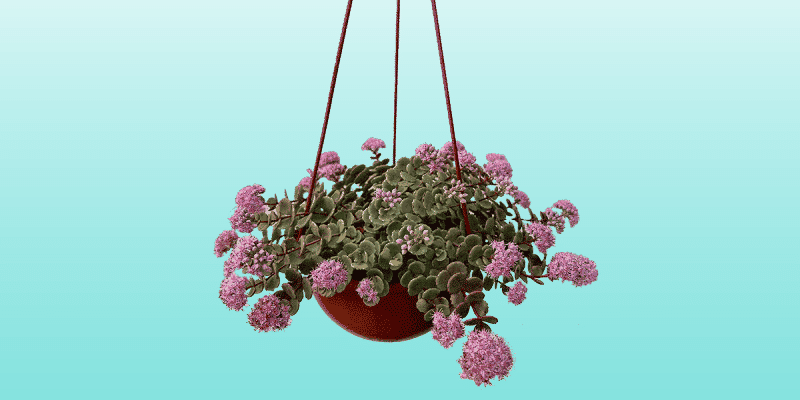String of hearts is the ultimate hanging plant. Its rows of heart-shaped dark green, white, and purple leaf pairs look stunning trailing down from high locations.
Maximum elegant bookshelf look, minimal effort.
The String of hearts plant isn’t quite a succulent, but even for a delicate houseplant taking care of it is really simple.
In this article, we’ll explore its unconventional flowers, why the “taco test” is important for this plant, and provide a thorough care guide. We’ll also cover propagation and the most common issues which might come up.
Let’s get started!
Table of Contents
String of Hearts Care Guide
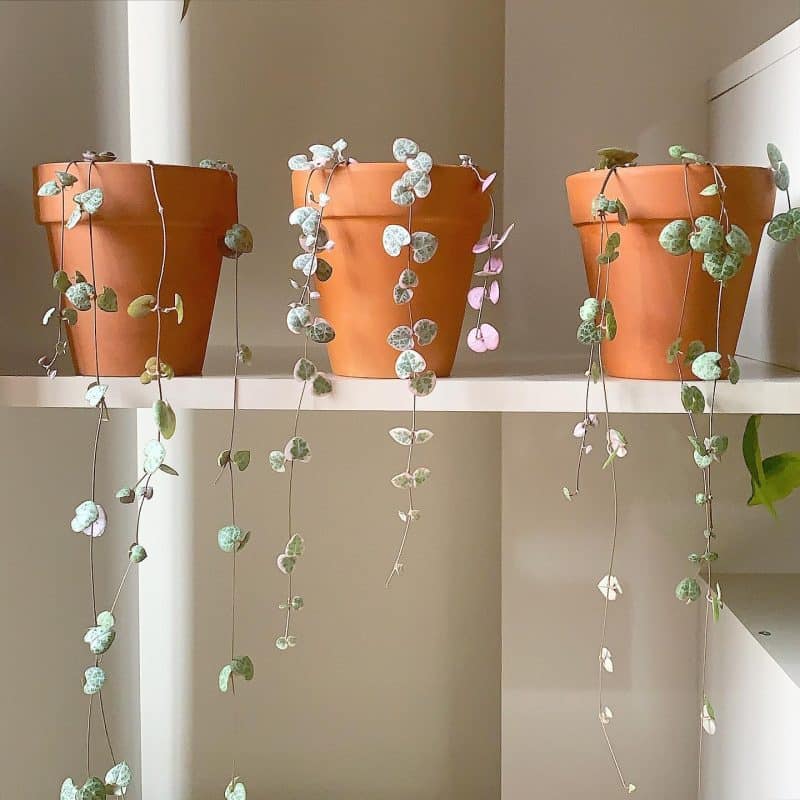
Ceropegia woodii, or string of hearts, comes from the Apocynaceae, or dogbane, family and is native to South Africa, Zimbabwe, and Swaziland. The botanist Carl Linnaeus who first observed the genus in 1753 thought its flowers looked like fountains of wax – so poetic! – so he named it Ceropegia, a combination of the Greek words keros, or wax, and pege, or fountain. The plant itself was first discovered hanging from rocks on a South African mountain by John Wood in 1881, hence the species name, woodii.
String of hearts is also called collar of hearts, chain of hearts, sweetheart vine, and hearts entangled, and it’s not hard to see why. With its green and white marbled heart-shaped leaves and delicate purple vines, these house plants look great trailing down walls, bookcases – you name it.
The string of hearts plant is also known as rosary vine, either because its hanging leaves look like a row of beads on a rosary, or the potato-like bulbs that form at its leaf bases resemble beads.
Stems can grow anywhere from 3 to 9 feet long, and leaves can grow 2-3 inches tall, about an inch apart from one another. As it grows, it develops a bulbous base, or caudex, under the soil that looks like a potato.
If your plant has extensive purple and cream margins, it’s likely the Ceropegia woodii ‘variegata,’ or the variegated string of hearts.
These guys are very fast growers that can spread out anywhere from 8-12 inches during the spring and summer months, and can take anywhere from 2-5 years to achieve their full height. They tend to get bigger when grown outdoors – though it’s not a problem if you’re growing indoors.
Although it looks like a succulent plant, string of hearts is actually categorized as a semi-succulent plant like String of Turtles (this doesn’t change how you’ll take care of it, though, don’t worry).
Speaking of string of hearts care, let’s get into the best light, temperature, humidity, and soil conditions for this plant. It can be propagated in four different ways, which I’ll also cover.
Lighting
Where should I put my string of hearts?
String of hearts loves bright indirect light, so put it at least three feet away from a south or west-facing window. Many people place their plant somewhere high where its vines have room to cascade, emphasizing their trailing, tangling nature.
Pro tip: If you find that your chain of hearts is bushy on the bottom and scraggly higher up, the top of its soil may be too high to receive enough light. It will look sparse if the light levels are too low, since the internodes, or distances between leaves, will be greater.
Try a spot where all parts of your plant gets equal sunlight, like the second highest shelf of a bookcase or kitchen shelf.
Do string of hearts need sun?
Like all house plants, string of hearts needs sun or at least some artificial light. It thrives in at least three to four hours of bright light a day, but only indirect. Too much direct sun will scorch its leaves, so if you have it by a window where this is the case, consider hanging a sheer fabric to diffuse the light.
Rotate your plant regularly to make sure all sides of it receive light and achieve the same marbled coloring (less light equals paler green leaves with less variegation).
Water
How often should I water my string of hearts?
String of hearts prefers to be underwatered than overwatered. Water it thoroughly every 7-10 days in the spring and summer. In autumn and winter, this plant goes dormant, so you don’t need to water it until the soil is completely dry, which will be every 3-4 weeks.
Remember that string of hearts plants store water in their leaves, so you can be a little more lenient than you’d otherwise be with other house plants.
How do you know when string of hearts needs water?
This plant needs water when:
- The top 2 or 3 inches of soil is dry during the spring and summer months.
- The entire pot is dry during the winter months.
- Its leaves feel soft and bend easily. Wait until you can fold the leaves together like a taco before watering again. This is known as the “taco test” (are you hungry yet?).
Pro tip: In order to prevent overwhelming it, consider bottom watering your plant. This allows its roots to suck up what they need, while preventing the soil from retaining too much moisture and causing root rot.
Bottom water a plant by putting the bottom 1/4 of the pot in water for 10 minutes. Let it drain before you place it back in its original location.
Temperature and humidity
As a tropical plant, string of hearts prefers temperatures above 70°F and humidity levels around 40 to 50%. While it is fairly resistant to the cold, like all tropical plants, the string of hearts will struggle with sudden temperature changes, so make sure to place it away from drafty air vents or windows.
Soil and planting
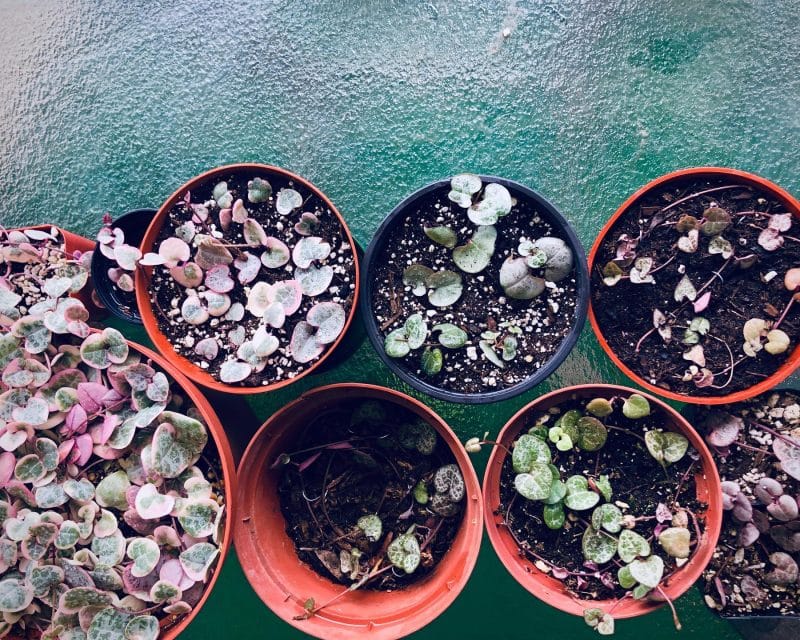
What soil is best for variegated string of hearts?
Due to their succulent-like nature, these plants thrive in USDA Zone 10 or above, so a well-draining soil succulent or cactus growing medium is the best bet. Like with all other plants, ensure their pot has at least one good drainage hole. Letting the string of hearts sit in wet soil that doesn’t breathe will damage its roots.
They don’t need much fertilization – during the growing season, use a 50% houseplant fertilizer once a month at most. And string of hearts plants don’t need to be fertilized at all during winter, when they go dormant.
Tubers, flowers, and blooms
You may notice white patches at leaf nodes that soon turn into white balls. These are called aerial tubers, also known as bulbils, and you can use them to propagate your plant (I cover this later).
A thriving string of hearts has distinctive inch-long pink and white blooms in the summer and fall, although they can show up at other times. The bulbs are capped by five purple petals that come together at the top to resemble a cage-like canopy or upside-down vase.
Once the flowers die, you can pull or cut them off for appearance’s sake, but you don’t have to. If you do, remove flowers carefully to avoid damaging the plant’s fragile stems.
You may also notice that they produce seeds as well, in a small vanilla-like pod.
Rare String of hearts varieties
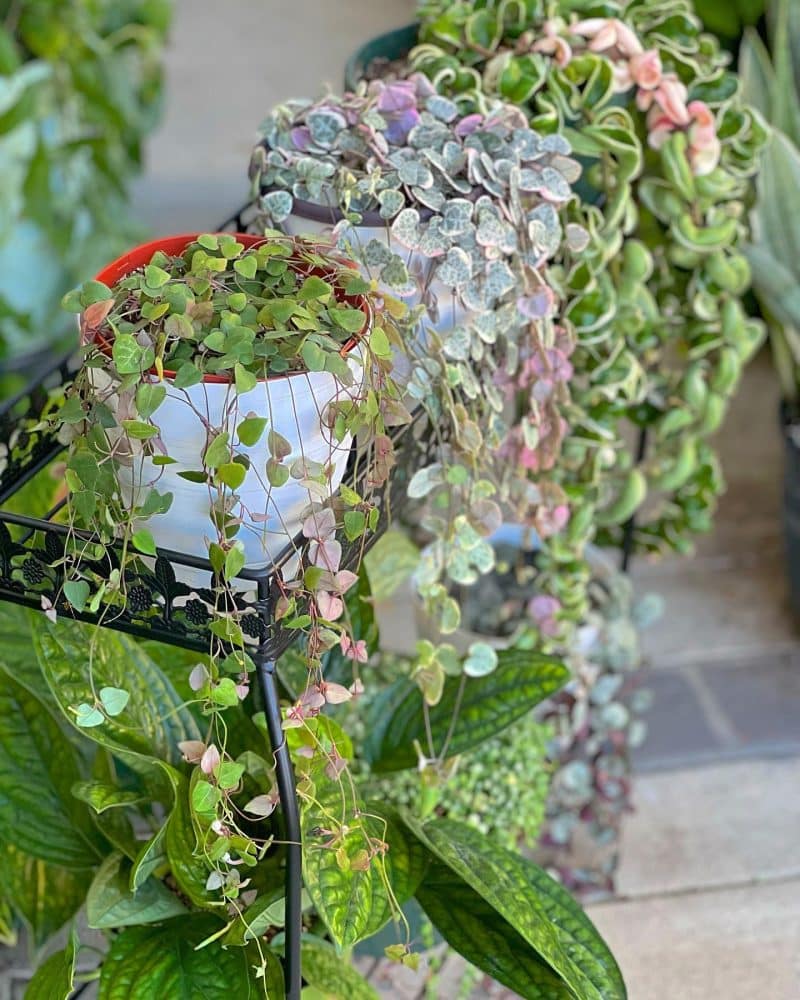
The care for ceropegia woodii varieties is basically the same as for any string of hearts, but keep in mind that the more variegated a plant is, the more indirect light they might require (as they have less chlorophyll).
Silver Glory String of Hearts
If your plant has variegated silver markings but its leaf ends are less pointy, then you have the super rare ‘Silver Glory’ cultivar. Its leaves appear more like tiny apples or pumpkins than hearts.
Mini Star String of Hearts
Also a rare variety, the ‘Mini Star’ features brighter green leaves with lighter green marbling and light pink stems. It lacks the burgundy leaf underside.
Orange River String of Hearts
While Orange River string of hearts might appear to be just another garden variety, when exposed (or sun stressed) to a little too much light, they start turning a beautiful shade of orange.
Why is this?
Well, just like a variegated string of hearts can turn completely green if given too much light, a lot of succulents (and related plants) will release a pigment called anthocyanins to protect/down-regulate chlorophyll from UV light.
This same pigment is responsible for giving these plants their beautiful orange hue, so experiment and feel free to push the Orange River to its limits. If you start seeing the tips or outside of the leaves change color to orange, you know you’re on the right track. If they turn brown or start shriveling up, you need to cut the light.
How to Propagate String of Hearts
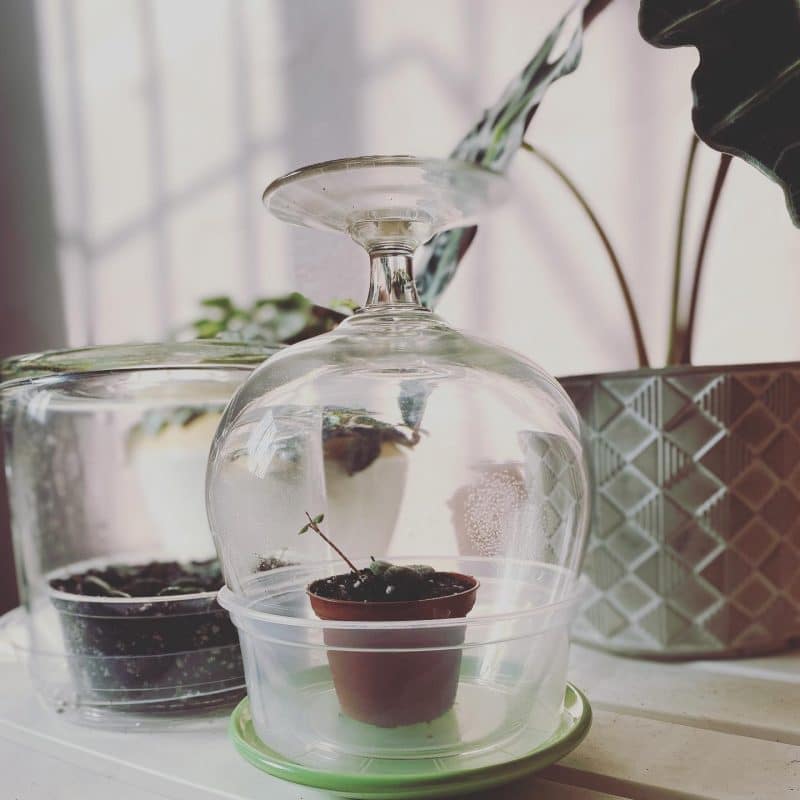
Okay, so unlike most indoor plants we cover, the string of hearts has four different methods of propagation that all work well.
So which should you choose?
- Water propagation. Choose this method if you’ve propagated plants by water before and you want a method that’s familiar.
- Sphagnum moss propagation. Pick this method if you want a fuller plant that will propagate and grow a lot faster. The stem nodes will have contact with a mixture of water and air, giving them the ideal environment for root growth.
- Soil propagation. Similar to water propagation, pick this method if you’ve done it before and are looking for fewer steps (other than potentially repotting).
- Tuber propagation. This is my least favorite method, but because it is possible (and in theory shocks the plant less) you might want to take the opportunity to try it.
To propagate your string of hearts by water
- Cut off two or more inches of vine with a sharp instrument like scissors or shears. These will function as stem cuttings.
- Put each propagating string in a vase or glass filled with water in a warm, well-lit area.
- Roots will form new growth in a couple of days.
- When roots are at least an inch long, bury them gently in well-draining soil (this can be in the same pot as the mother plant or a different one).
To propagate your string of hearts in sphagnum moss (“butterfly” propagation method)
- Keep each heart pair (the “butterfly”) together and cut them at the node, or where the leaves sprout, together as one section, leaving a one-fourth inch of vine at each end. Cut as many as you’d like. (This is a great video showing a step-by-step breakdown of the butterfly method).
- Soak a generous bunch of sphagnum moss in warm water for five minutes.
- Take a clear plastic container that has a lid and make it into a propagation box (takeout containers or Tupperware would be a good option here, for instance) by putting in a thick layer of the now-wet sphagnum moss.
- Place the leaf pairs on the moss so their nodes are making contact and close the lid. Note that the back of the leaves should face downward and the front heart shapes should face upward, otherwise the nodes are pointed in the wrong direction and won’t root properly.
- Keep the box in a bright, warm area, and you’ll see roots form in a week or two, with vine offshoots appearing shortly after.
- Plant the newly sprouted cuttings in a soil mix that drains well, and don’t worry if some of the moss comes along too – it will only help aerate the soil. And that’s a good thing.
To propagate your string of hearts plant in soil:
- Cut off two inches of a vine with scissors or shears (this part might sound familiar!).
- Take off the bottom leaves so that only the bare vine goes into the soil.
- Cover the bottom vine nodes with cactus or succulent soil in a warm area with bright light.
- Water the soil once a week, keeping it slightly moist but not drenched. Roots should grow within a few days.
To propagate your string of hearts plants with tubers:
- Try to find the biggest one you can – one about the size of a fingernail is ideal.
- Here you have a choice, to leave the tuber on the vine and press it gently down into the soil of the existing pot, or cut off the grow string with the tuber and plant it in another pot.
- For either method, add a little sand under the tuber to avoid root rot.
- If you leave the vine and tuber attached to the mother plant, it will begin to form roots in about eight weeks. You can leave this new root system in the same pot if you want to make your string of hearts look fuller, or you can tug gently to determine whether the roots are strong enough to cut and replant in a new pot.
- If you plant the vine and tuber in another container, use succulent or cactus soil mix to just cover the tuber. Make sure it’s in a spot with bright but indirect light and gets watered every week or so. It will grow roots in a few weeks.
Common Issues
When getting started with an indoor plant (and the string of hearts can be a little tricky) it can be discouraging when things don’t look quite like they do on Instagram (or at your friend’s house). Don’t worry: most of this plant’s problems are caused by watering or light issues, making them super easy to solve.
Brown or crispy leaves. Your plant is getting too much sunlight. Direct sunshine will burn this plant, resulting in brown or crumbly leaves and stunted growth. String of hearts need bright and indirect light. Move it farther away from a light source or try covering the window with a sheer curtain.
Pale leaves. If its normally white-patterned leaves are pale and don’t seem to have as much mottled white, your light conditions aren’t ideal. This is also true if the leaves are farther apart than normal. Move it closer to a light source.
Shedding leaves. If overwatered, your plant will rapidly lose leaves and they’ll also change color to a yellow, black, or brown.
Mushy leaves. This is also a result of overwatering. Only water your plant when there are two to three inches of dry soil in the growing season, and let the soil dry out completely in the winter. Make sure any pot you’re using has adequate drainage so the string of hearts plant’s root system can breathe.
Thin, curling leaves. If this plant’s leaves are curling and look thin, it isn’t getting enough water. String of hearts store water, so when their leaves are firm and fat, you’ll know you’ve found a good watering schedule.
Tangling stems. I personally view this as more of a feature than a problem, but if you’re not a fan of tangled stems, extricate each stem gently, being careful not to damage them in the process, since they’re delicate. Keep heart plants away from open windows where a breeze might encourage tangling, and be careful around small children who might like to grab a colorful new plant “toy.”
Diseases and Pests
Your string of hearts plant can succumb to most of the common diseases and pests that can plague most houseplants, but keep in mind that a healthy plant usually has all the tools its needs to fight off these predators.
Root rot. Unfortunately a common issue for plants that were poorly shipped, with compacted soil, or from overwatering. Pull up your plant, inspect the roots cutting off any that are rotting/dead (they’ll be wet/slimy). Repot in an airier soil mix and make sure the pot has well-sized drainage holes. Most plants can be recovered! If you’re doubtful that you can recover the mother plant, you can use this as an opportunity to take stem cuttings and begin propagating some healthier plants.
Mealybugs, aphids, thrips. Soapy water works great, but thrips and other insects will lay eggs in tiny holes that they eat out of your plant, making it hard to get them with the water. Adults also have wings, so you also need to treat any other plants in the same area. So make sure to keep up on your treatment so the larvae die off before they can complete their lifecycle. If soapy water doesn’t work, use 50% diluted neem oil and water and spray your plant weekly, making sure to get under its leaves, until the insects are gone.
Conclusion
The string of hearts is instantly recognizable for its romantic heart-like leaves on trailing vines. It prefers bright, indirect light and won’t fare well in direct sunlight, flourishing in warm temperatures above 70 degrees Fahrenheit and 40-60% humidity.
Water after performing the “taco test” or when the soil gets dry. Create new plants for your friends or make your string of hearts plant bushier through tuber, water, or soil propagation.
If you want extra quick, full-looking plants, try the butterfly propagation method. With swift growth, you’ll soon have an impressive collection of cascading purple vines.
If you find this article helpful, share it with a friend who might want to grow their own string of hearts. If you have any suggestions or questions, feel free to get in touch on Instagram or Twitter!
FAQ
Do strings of hearts like being misted?
I would not recommend misting this plant, since it should be able to get all the moisture it needs from consistent watering. As a semi-succulent, its leaves actually retain and store moisture, so misting it in addition to what it gets from soil watering will just provide an opportunity for leaf rot.
What should string of hearts be planted in?
These plants should be placed in a pot with well-draining soil like a succulent or cactus mix. Regular potting mix will be too dense for them and cause root rot.
Do String of hearts produce seeds?
Pollinated string of hearts plants will grow seed pods shaped like long green horns. Inside are stacks of seeds that look like milkweed seeds. If you’re lucky enough to get a pollinated plant, you can propagate by seed in addition to the four other methods mentioned above – tuber, water, soil, and sphagnum moss.

